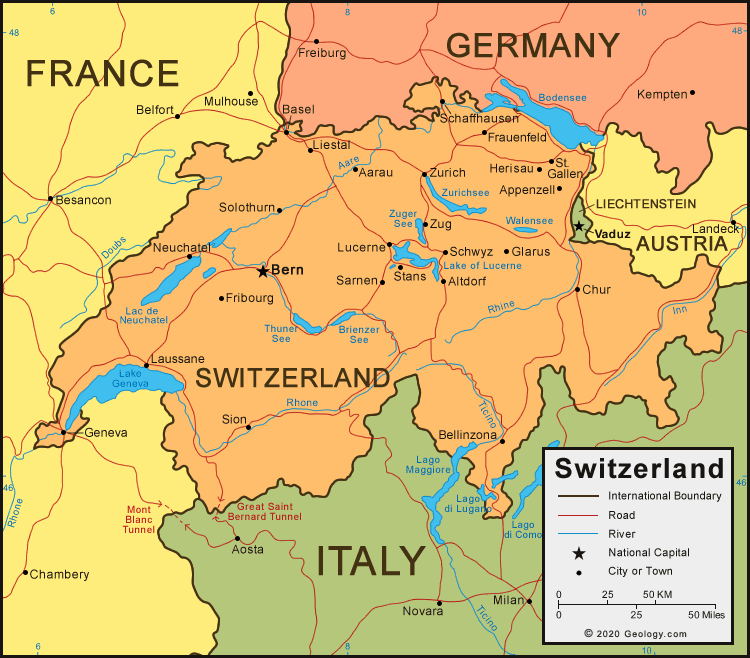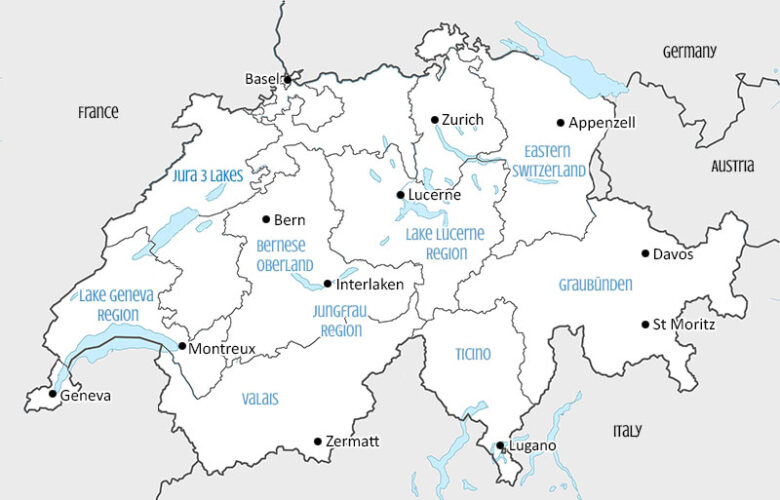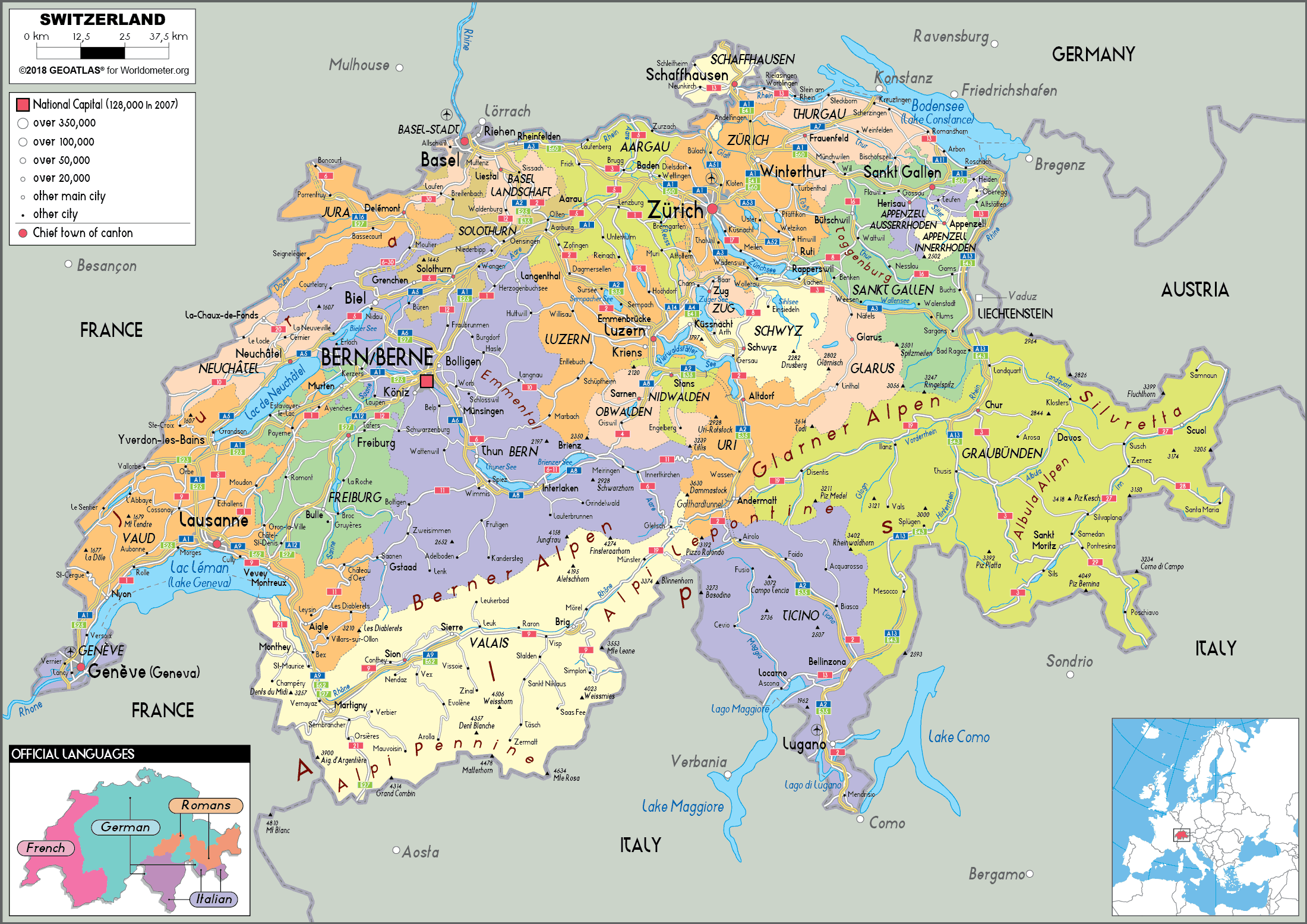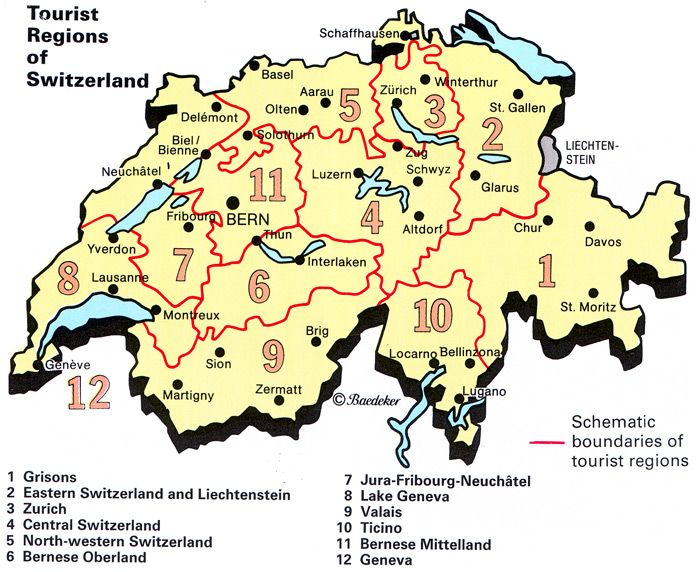Map Of Switzerland - Key Cities, Routes, And Regions
Plan your Switzerland adventure with the ultimate map guide. Key cities, attractions, and regions all covered for your convenience.
Author:Michael RachalReviewer:Finn WildeDec 07, 20241.2K Shares61.5K Views

Switzerland’s map offers a glimpse into a country rich in diversity, with each region reflecting unique cultures, languages, and landscapes. From the bustling cities of Zurich and Geneva to the peaceful peaks of the Swiss Alps, the geography of Switzerland showcases its multifaceted charm.
Each region, from the German-speaking heartland to the Italian-influenced Ticino, brings its own traditions and attractions. This article highlights the key regions and their distinct features, offering a deeper understanding of what makes Switzerland so special.
Quick Facts
- Capital: Bern
- Official Languages: German, French, Italian, Romansh
- Currency: Swiss Franc (CHF)
- Population: Approximately 8.5 million
- Area: 41,290 square kilometers
- Time Zone: Central European Time (CET) / Central European Summer Time (CEST)
- Calling Code: +41
- Government: Federal Republic
- Famous for: Chocolate, cheese, watches, and the Swiss Alps
Overview Of Switzerland's Geography
Switzerland is a landlocked country located in Central Europe, bordered by France, Germany, Austria, and Italy. Its compact size belies its diverse geography, which includes towering mountains, deep valleys, pristine lakes, and lush forests. Switzerland is also known for being one of the best destinations for remote work, offering stunning landscapes, a high quality of life, and excellent infrastructure for digital nomads.
- Swiss Alps: The Swiss Alps, home to the highest peaks in the country, dominate much of the landscape. The Alps stretch across the southern part of Switzerland and are a key feature on any map of Switzerland. Peaks like the Matterhorn and Mont Blanc attract tourists, hikers, and climbers year-round.
- Swiss Plateau: In contrast to the mountainous south, the Swiss Plateau lies to the north and is characterized by rolling hills, farmland, and the country's major cities, including Zurich, Geneva, and Bern.
- Lakes: Switzerland is also home to several beautiful lakes, such as Lake Geneva, Lake Zurich, and Lake Lucerne, which play an important role in the country’s tourism and economy. These lakes are prominent features on maps, helping tourists navigate to some of Switzerland’s most scenic spots.
Map Of Switzerland’s Cities
1. Zurich
Zurich is the largest city in Switzerland and the country's financial hub. Located in the northern part of Switzerland on the shores of Lake Zurich, it is known for its banking industry, museums, art galleries, and vibrant nightlife. Zurich also offers a mix of old and new, with its medieval Old Town (Altstadt) and modern, cosmopolitan vibe. It is often ranked as one of the best cities in the world for quality of life.
2. Geneva
Geneva, located at the western tip of Switzerland, is the second-largest city in the country and one of the most internationally recognized cities. It is home to the United Nations and the Red Cross, making it an important center for diplomacy. Situated on the shores of Lake Geneva and surrounded by the Alps, the city also offers stunning natural beauty along with its rich cultural heritage.
3. Basel
Basel, located in the northwestern part of Switzerland, lies along the banks of the Rhine River. Known as the cultural capital of Switzerland, Basel is famous for its museums, galleries, and theaters, including the renowned Art Basel fair. The city is also an important center for pharmaceuticals and chemical industries, with major companies like Novartis and Roche headquartered there.
4. Bern
Bern, the capital of Switzerland, is located in the central part of the country. Known for its medieval architecture, Bern’s Old Town is a UNESCO World Heritage Site. The city is also home to the Swiss government, and its charming streets, clock tower (Zytglogge), and vibrant markets make it one of the most picturesque cities in the country. Bern is a political and cultural center, with numerous museums and galleries to explore.
5. Lucerne
Lucerne, situated in central Switzerland, is a popular tourist destination known for its well-preserved medieval architecture and stunning location on Lake Lucerne, surrounded by mountains. The city is famous for landmarks such as the Chapel Bridge (Kapellbrücke), Lion Monument, and its proximity to Mount Pilatus and Mount Rigi. Lucerne is also a cultural hub, hosting the Lucerne Festival, a prominent classical music event.
6. Lausanne
Lausanne is a vibrant city located on the northern shore of Lake Geneva, near the French border. Known as the headquarters of the International Olympic Committee, Lausanne is a city that blends modernity with tradition. The city features beautiful architecture, including the Gothic Lausanne Cathedral, and offers a lively arts scene, upscale shopping, and fine dining.
7. St. Moritz
St. Moritz, located in the Swiss Alps, is a world-renowned luxury resort town. Famous for its winter sports, particularly skiing and snowboarding, St. Moritz has hosted the Winter Olympics twice. The city is also known for its upscale hotels, high-end shopping, and glamorous social scene. It is one of Switzerland’s most exclusive destinationsfor both winter and summer tourism.
8. Lugano
Lugano is the largest city in the Italian-speaking region of Switzerland, located in the southern part of the country in the canton of Ticino. Situated on the shores of Lake Lugano and surrounded by mountains, the city has a Mediterranean flair, with palm-lined streets and beautiful parks. It is also an important financial center and offers a range of cultural attractions, including museums, theaters, and a vibrant culinary scene.
9. Winterthur
Winterthur, located in the Zurich metropolitan area, is Switzerland’s sixth-largest city and is known for its art, culture, and history. The city boasts a wealth of museums, including the renowned Swiss Science Center Technorama, and a rich industrial heritage. The Old Town offers charming streets, historical buildings, and lively marketplaces, while the city’s green spaces and parks provide a peaceful retreat.
10. Thun
Thun is a small city located on the banks of Lake Thun in the Bernese Oberland region. Known for its medieval architecture, including the Thun Castle, the city offers a blend of historical charm and natural beauty. The picturesque Old Town is set against the backdrop of the Swiss Alps, and visitors can enjoy boat tours on the lake or explore the nearby mountains.
11. Zug
Zug, a small but prosperous city located on the shores of Lake Zug, is known for its business-friendly environment and low taxes, attracting international corporations. Despite its small size, Zug offers a beautiful medieval Old Town, picturesque lake views, and a tranquil atmosphere. The city is also home to many outdoor recreational activities, including hiking, cycling, and sailing.
12. Chur
Chur is the oldest city in Switzerland, located in the eastern part of the country in the canton of Graubünden. It is known for its historical sites, including the Chur Cathedral and the Old Town, with its narrow, winding streets. Chur serves as a gateway to the Swiss Alps and is the starting point for the famous Bernina Express and Glacier Express train routes.
13. Sion
Sion, located in the Valais region of Switzerland, is a historic city that boasts a number of ancient sites, including the Château de Tourbillon and the Château de Valère. The city sits in the heart of the Rhône Valley, surrounded by vineyards and alpine peaks, making it a hub for both culture and tourism. Sion also hosts several cultural events and festivals throughout the year.
14. Aarau
Aarau is located in the northern part of Switzerland, in the canton of Aargau. Known for its charming Old Town, Aarau is a city with a rich history and beautiful Baroque architecture. It is an important regional center for industry, commerce, and education, offering a mix of urban amenities and scenic countryside.
15. Neuchâtel
Neuchâtel, located in the western part of Switzerland, is known for its watchmaking industry and beautiful lakefront. The city has a rich history, with landmarks such as the Neuchâtel Castle and the Gothic-style Collegiate Church. The city also features a blend of French-speaking culture and Swiss traditions, making it a unique place to visit.
Regions On The Map Of Switzerland
1. German-speaking Switzerland (Deutschschweiz)
German-speaking Switzerland, also known as Deutschschweiz, is the largest linguistic region in Switzerland. This region includes the central, northern, and eastern parts of the country, and it is home to major cities such as Zurich, Basel, and Bern. German is the predominant language spoken here, although various dialects of Swiss German are used in everyday life.
This region is the economic powerhouse of Switzerland, with Zurich being the financial capital, and Basel serving as a global hub for pharmaceuticals and life sciences. Many consider this region to be one of the best places in Europe, offering a unique mix of modern urban living and natural beauty that draws visitors year-round.
Key characteristics:
- Major cities: Zurich, Basel, Lucerne, Bern
- Economic and cultural heart of Switzerland
- Famous for its lakes, including Lake Zurich and Lake Lucerne
- Rich historical sites, such as the medieval Old Towns of Zurich and Bern
2. French-speaking Switzerland (Romandy)
French-speaking Switzerland, or Romandy, is located in the western part of the country. It includes the cantons of Geneva, Vaud, Neuchâtel, and Jura. The primary language spoken here is French, and the culture is more influenced by French traditions. Geneva, an international city, is located in this region and is home to numerous global organizations, including the United Nations. The region is known for its beautiful lakes (Lake Geneva and Lake Neuchâtel) and picturesque towns like Lausanne.
Key characteristics:
- Major cities: Geneva, Lausanne, Neuchâtel, Fribourg
- Cultural and economic ties to France
- Known for wine production, particularly around Lake Geneva
- Rich in cultural institutions, museums, and international organizations
3. Italian-speaking Switzerland (Ticino)
The southern region of Switzerland, Ticino, is the only canton where Italian is the official language. It is located in the Italian-speaking part of the country, bordered by Italy to the south. Ticino is famous for its Mediterranean feel, with palm trees, mild winters, and a relaxed atmosphere. The canton’s main city, Lugano, is known for its lakeside views, parks, and vibrant arts scene. The region's cuisine, architecture, and traditions have a strong Italian influence.
Key characteristics:
- Major cities: Lugano, Locarno, Bellinzona
- Influenced by Italian culture and language
- Beautiful lakes, including Lake Lugano and Lake Maggiore
- Mediterranean-style climate, with palm trees and mild winters
4. Romansh-speaking Switzerland (Grisons Or Graubünden)
The Romansh-speaking region, found in the canton of Graubünden (Grisons), is the smallest linguistic region in Switzerland. Romansh is one of Switzerland’s official languages, though it is spoken by only a small portion of the population. Graubünden is known for its rugged, mountainous terrain, and it is home to popular tourist destinations like St. Moritz and Davos. This region is famous for its ski resorts, hiking trails, and pristine alpine lakes.
Key characteristics:
- Major cities: Chur, Davos, St. Moritz
- Famous for outdoor activities like skiing, hiking, and mountaineering
- Scenic alpine landscapes, including the Engadine Valley
- Unique culture with traditional Romansh language and customs
5. The Alpine Region
Switzerland’s Alpine Region includes the entire southern and eastern portions of the country, where the Swiss Alps dominate the landscape. This region is famous for its high mountains, glaciers, and world-class ski resorts. Iconic peaks like the Matterhorn, the Eiger, and the Jungfrau are found in the Alpine Region, making it a popular destination for outdoor enthusiasts, particularly skiers, mountaineers, and hikers.
Key characteristics:
- Major cities: Zermatt, Interlaken, Andermatt
- Famous for skiing and alpine sports
- Home to the Swiss Matterhorn, Eiger, and Jungfrau mountains
- Rich in natural beauty, including waterfalls, lakes, and alpine meadows
6. The Swiss Plateau (Mittelland)
The Swiss Plateau or Mittelland is a lowland region that stretches from the Jura mountains in the west to the Alps in the east. This region is highly developed and includes some of Switzerland’s most populous and economically significant cities, such as Zurich, Bern, and Basel. It is known for its agricultural activities, particularly dairy farming, and its industrial base, with major sectors including technology, pharmaceuticals, and manufacturing.
Key characteristics:
- Major cities: Zurich, Bern, Basel, Lucerne
- Highly urbanized and industrialized
- Fertile farmland, ideal for agriculture
- Known for its efficient transport networks and high standard of living
7. The Jura Region
The Jura Region is located in the northwest of Switzerland, bordering France. The Jura Mountains are a key feature of this region, which is known for its rural character, deep forests, and watchmaking industry. The Jura is also a popular area for hiking, cycling, and other outdoor activities. The region’s watchmaking heritage, particularly in the town of Biel/Bienne, plays a significant role in Switzerland's global reputation for precision craftsmanship.
Key characteristics:
- Major cities: Neuchâtel, Biel/Bienne, Delémont
- Famous for watchmaking, particularly in Biel/Bienne
- Scenic Jura mountains and rolling hills
- A blend of French and Swiss culture, with a focus on outdoor tourism
8. Central Switzerland
Central Switzerland is characterized by its stunning lakes, rolling hills, and iconic mountain ranges, including the Rigi and Pilatus. This region is both a popular tourist destination and a key cultural area. Cities such as Lucerne, which is known for its medieval Old Town and beautiful lakeside views, are part of this region. Central Switzerland offers a blend of nature, history, and Swiss traditions.
Key characteristics:
- Major cities: Lucerne, Zug, Schwyz
- Known for breathtaking lakes, such as Lake Lucerne
- Famous for hiking, particularly around Mount Pilatus and Mount Rigi
- A hub of traditional Swiss culture and festivals
9. Eastern Switzerland
Eastern Switzerland includes the cantons of St. Gallen, Thurgau, and Appenzell. This region is known for its rolling hills, green landscapes, and historical towns. St. Gallen is home to the famous Abbey of St. Gall, a UNESCO World Heritage site. The region also offers a variety of outdoor activities, including hiking, cycling, and skiing in the winter months.
Key characteristics:
- Major cities: St. Gallen, Appenzell, Frauenfeld
- Rich in history and culture, particularly in St. Gallen
- Beautiful landscapes, including rolling hills and vineyards
- Popular for outdoor activities and winter sports in the Alps
Government Of Switzerland
Switzerland operates under a federal system, meaning that power is shared between the central government and the 26 cantons (regions). The country is known for its direct democracy, a system that allows citizens to actively participate in decision-making processes through referendums and initiatives.
1. Federal Government
The Swiss federal government is a multi-party system, with the most significant political parties being the Swiss People's Party (SVP), the Social Democratic Party (SP), the FDP.The Liberals, and the Christian Democratic People's Party (CVP). The federal government is responsible for national matters such as foreign policy, defense, national transportation, and social security.
Switzerland is unique in that it has a Federal Council, which is the executive branch of government. Instead of a single president, the Federal Councilis made up of seven members who share executive powers equally. The Federal Council members are elected by the Federal Assembly(parliament) for a four-year term.
2. Federal Assembly (Parliament)
The Swiss Federal Assemblyis the country's bicameral parliament, consisting of two chambers:
- The National Council (Lower House): It has 200 members who are elected based on proportional representation from the cantons. This chamber represents the people.
- The Council of States (Upper House): It has 46 members, with two representatives from each canton (and one from each half-canton). The Council of States represents the cantonal interests.
Both chambers of the Federal Assembly work together to legislate, amend the constitution, and approve the federal budget. The Swiss parliament is responsible for proposing, reviewing, and passing laws that affect the country.
3. Direct Democracy
Switzerland is widely known for its direct democracysystem. Citizens have the right to propose changes to the constitution or request a referendumon a proposed law. This gives the people more influence on national legislation than in most other democratic nations. There are three main tools of direct democracy:
- Referendums: If citizens or a group of cantons challenge a law passed by parliament, they can call for a referendum. If at least 50,000 signatures are collected within 100 days, a nationwide vote is held. If the majority votes against the law, it is rejected.
- Popular Initiatives: This allows citizens to propose new laws or amendments to the constitution. If an initiative gathers 100,000 signatures within 18 months, it is put to a national vote.
- Optional Referendum: When parliament passes a law, citizens have the option to challenge it. If 50,000 signatures are collected, a national referendum is held to approve or reject the law.
4. Judiciary
The Swiss judiciaryis independent and operates under the rule of law. The highest court in Switzerland is the Federal Supreme Court, located in Lausanne. The court’s role is to ensure that federal laws and the constitution are upheld and interpreted correctly. The Swiss judicial system ensures a balance of power, providing checks and balances on the legislative and executive branches.
5. Federalism And Cantons
Switzerland’s cantons have a significant degree of autonomy, with each canton having its own constitution, government, and parliament. The Swiss Constitution outlines the powers shared between the federal government and the cantons, but cantons retain significant authority over areas such as education, health, and local law enforcement.
Each canton elects its own officials and has its own policies and laws, which can vary greatly depending on the region. For example, laws concerning education and social welfare programs may differ significantly from one canton to another.
6. Swiss Presidency
Switzerland does not have a Presidentin the traditional sense. Instead, the head of state is elected from among the seven members of the Federal Council. The role of President of the Swiss Confederationrotates annually among the members of the Federal Council. The president's duties are mainly ceremonial, acting as a representative of the country in international matters. The presidency is not a position of executive power or authority.
Key Features Of Switzerland’s Government
- Neutrality: Switzerland has a long-standing policy of political neutrality, which means that it does not engage in military alliances or international conflicts. This neutrality is enshrined in the country's constitution and is a key part of Switzerland's identity.
- Consensus Politics: Swiss political culture is centered around consensus and compromise. The Federal Councilworks collaboratively, and decisions are typically made through consensus rather than majority rule. This ensures that all political parties and regions have a say in the decision-making process.
- High Level of Decentralization: The cantons have significant authority over many aspects of governance, such as education, healthcare, and local law enforcement. This decentralization ensures that policies are tailored to local needs and preferences.
- Citizens' Rights: Switzerland places a high value on its citizens' rights and political participation. The right to vote is granted to all Swiss citizens over the age of 18, and the Swiss system of direct democracyensures that citizens can influence legislation and government policy directly.
Dialing Code Of Switzerland
The dialing code for Switzerland is +41. This code is essential when making international phone calls to Switzerland from abroad.
Currency Of Switzerland
Switzerland’s official currency is the Swiss Franc (CHF). The Swiss Franc is considered one of the most stable currencies in the world and is used across all regions of Switzerland, regardless of the language spoken.
Capital Of Switzerland
The capital of Switzerland is Bern. Located in the central part of the country, Bern is the political center of Switzerland, housing the federal government and various international organizations. The city is known for its well-preserved medieval architecture, including the iconic Zytglogge clock tower, and its charming old town, which is a UNESCO World Heritage site. While Bern is not Switzerland's largest city (Zurich holds that title), it plays a crucial role as the administrative and cultural heart of the nation.
Language Of Switzerland
Switzerland is a multilingual country with four official languages:
- German: Spoken by the majority, particularly in the central and eastern parts of the country.
- French: Predominantly spoken in the western part of Switzerland, including cities like Geneva and Lausanne.
- Italian: Spoken in the southern canton of Ticino, bordering Italy.
- Romansh: A rare language spoken by a small minority in the canton of Graubünden.
These languages reflect the cultural diversity of Switzerland and are important to understand when exploring the country through a map.
Flag Of Switzerland
The flag of Switzerland consists of a red square with a white cross in the center. The white cross is a symbol of neutrality and peace, values that are core to Switzerland’s national identity. The flag is widely recognized around the world and is an important national symbol.
Types Of Maps Of Switzerland
1. Physical Maps
A physical map of Switzerland shows the country's natural features, such as mountains, rivers, valleys, and lakes. These maps highlight the topographical differences between the Alpine regions and the flatter, urbanized plateau. Physical maps are essential for outdoor activities like hiking, skiing, or studying the country’s geology. Switzerland is also one of the top cruise travel destinations, offering scenic lake cruises that allow travelers to explore its breathtaking landscapes from a unique perspective.
- Key Features: The Matterhorn, the Rhine River, and Lake Geneva are highlighted prominently on physical maps.
- Use for Travelers: These maps are especially helpful when planning trips to the Alps or exploring Switzerland’s hiking trails.
2. Political Maps
Political maps focus on the administrative divisions of the country, such as cantons, major cities, and borders. Switzerland is divided into 26 cantons, each with its own culture, language, and traditions. A political map allows you to easily identify the capital cities and major towns.
- Key Features: Major cities like Zurich, Geneva, and Bern, as well as the cantons, are displayed clearly.
- Use for Travelers: These maps are particularly helpful for understanding the political structure of Switzerland and for travelers who want to learn more about the cultural differences across the regions.
3. Topographic Maps
Topographic maps provide detailed information about the elevation of the land and its contours. These maps are ideal for those looking to explore the natural environment, especially for outdoor activities such as hiking, mountaineering, and skiing.
- Key Features: Elevation lines, mountain ranges, and valleys are clearly marked.
- Use for Travelers: Topographic maps are essential for hikers and adventurers who need precise details about terrain elevation and the steepness of trails.
4. Interactive Maps
In the digital age, interactive maps of Switzerland are gaining popularity. These maps allow users to zoom in on specific areas, view terrain details, and even get real-time updates on weather conditions, tourist attractions, and public transportation.
- Key Features: Digital mapping tools like Google Maps or dedicated Switzerland tourism apps allow users to explore regions, check routes, and get traveladvice.
- Use for Travelers: These maps are perfect for navigating the country while traveling, providing instant access to everything from scenic routes to local hotspots.
Major Routes And Highways In Switzerland
Switzerland’s road network is extensive, with highways and routes that are crucial for domestic travel. The A1highway runs from Geneva in the west to St. Gallen in the east, passing through Zurich, making it the backbone of Switzerland’s transportation system.
Other major highways include the A2, connecting Basel to Chiasso in the south, and the A3, which runs along the Rhine River. For travelers, these routes are essential when planning journeys between cities, and they are well-marked on maps of Switzerland.
How To Read And Use A Map Of Switzerland
1. Interpreting Elevation And Terrain
Maps of Switzerland often show contour lines, which indicate the elevation of the land. The closer the lines, the steeper the slope. If you’re planning to hike or ski, this information is crucial for understanding the difficulty of trails or the steepness of slopes.
2. Key Symbols And Icons
Maps use various symbols to represent key features such as hospitals, restaurants, train stations, or hiking trails. Familiarizing yourself with these symbols will make navigating the map easier.
3. Scale And Distance
Understanding the scale of a map helps you calculate distances between locations. It’s also helpful when determining how long a journey will take, whether you’re walking, driving, or taking public transport.
Best Maps For Travelers
When it comes to traveling in Switzerland, certain maps are better suited to different needs. Here are some of the best options:
1. Swiss Federal Railways (SBB) Maps
For visitors using public transportation, the SBB map is indispensable. It covers train, bus, and tram routes throughout Switzerland, making it easy to plan your travel efficiently.
2. Switzerland Tourism Maps
Switzerland Tourism offers detailed maps for visitors, which highlight major tourist attractions, hiking routes, and scenic drives. These maps are perfect for travelers exploring the country's iconic landmarks.
3. National Geographic Adventure Maps
If you're looking to explore Switzerland's outdoor activities, National Geographic’s adventure maps provide detailed information about hiking, biking, and skiing trails across the country.
Interesting Facts And Highlights About Switzerland
- Home of the Red Cross: Switzerland is the birthplace of the Red Cross, founded by Swiss businessman Henry Dunant in 1863.
- Neutral Country: Switzerland has maintained a policy of neutrality in international conflicts since the early 19th century.
- Swiss Watches: Switzerland is known worldwide for its high-quality watchmaking industry, with brands like Rolex, Patek Philippe, and Omega leading the market.
- The Alps: The Swiss Alps cover about 60% of the country's total area, making Switzerland a premier destination for skiing and mountaineering.
- Direct Democracy: Switzerland is famous for its direct democracy system, where citizens can propose and vote on referendums.
- Chocolate: Switzerland is home to some of the finest chocolates in the world, with brands like Lindt and Toblerone gaining global recognition.
- Multilingual Nation: The country has four official languages German, French, Italian, and Romansh reflecting its cultural diversity.
- Public Transportation: Switzerland’s public transportation system is one of the most efficient in the world, with extensive train, bus, and tram networks.
- Highest Quality of Life: Switzerland consistently ranks high in global quality of life indexes due to its excellent healthcare, education, and low crime rate.
- UNESCO World Heritage Sites: Switzerland has multiple UNESCO World Heritage Sites, including the Jungfrau-Aletsch-Bietschhorn and the old town of Bern.
FAQs
How Accurate Are Swiss Maps For Hiking?
Swiss maps, especially topographic ones, are extremely accurate and widely regarded as among the best in the world for outdoor activities. They provide detailed elevation data, trail markers, and route recommendations.
What Is The Most Famous Map Of Switzerland?
The most famous and widely used map is the Swiss Federal Map, which offers a comprehensive view of the country’s geography, including its mountainous terrain, cities, and road networks.
How Can I Get A Physical Map Of Switzerland?
Physical maps of Switzerland can be purchased at tourist shops, airports, or online from websites like SwissTopo or Switzerland Tourism.
What Types Of Maps Should A Tourist Use In Switzerland?
For tourists, a combination of political maps, tourist maps, and interactive digital maps is ideal for navigating the country. Topographic maps are also beneficial if you're planning outdoor activities like hiking.
Conclusion
Switzerland’s regions are as diverse as they are beautiful, each offering something unique. From the cultural vibrancy of its cities to the natural beauty of the Alps, the country’s geography plays a vital role in shaping its character and appeal. Understanding these regions enhances any visit to Switzerland, revealing the many layers of its identity.
Jump to
Quick Facts
Overview Of Switzerland's Geography
Map Of Switzerland’s Cities
Regions On The Map Of Switzerland
Government Of Switzerland
Dialing Code Of Switzerland
Currency Of Switzerland
Capital Of Switzerland
Language Of Switzerland
Flag Of Switzerland
Types Of Maps Of Switzerland
Major Routes And Highways In Switzerland
How To Read And Use A Map Of Switzerland
Best Maps For Travelers
Interesting Facts And Highlights About Switzerland
FAQs
Conclusion

Michael Rachal
Author
Michael Rachal believes that luxury lies in the details. With over 20 years of experience in the luxury travel industry, he has crafted hundreds of bespoke itineraries for clients seeking personalized, unforgettable experiences.
Whether guiding clients through private cultural tours or curating culinary journeys with world-renowned chefs, Michael ensures that each trip is tailored to perfection.
His ability to anticipate needs and exceed expectations has earned him a reputation as a leading expert in luxury travel.

Finn Wilde
Reviewer
For Finn Wilde, the wilderness is more than just a destination - it’s a way of life. Over the past decade, he has led multiple expeditions in some of the world’s most remote regions, from the icy fjords of Greenland to the rugged trails of Patagonia.
Finn emphasizes sustainability in all of his adventures, helping participants connect with nature while promoting responsible exploration. His expeditions inspire individuals to explore the great outdoors while fostering a deep respect for the environment.
Latest Articles
Popular Articles


